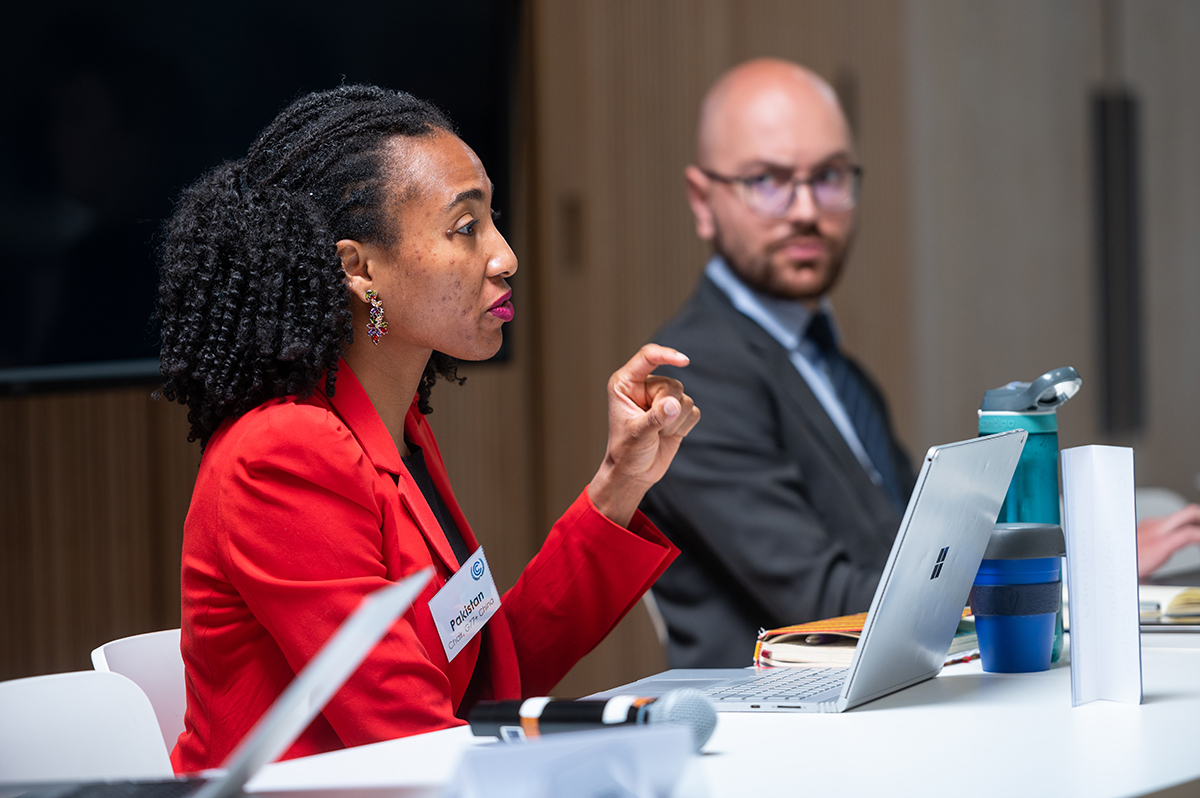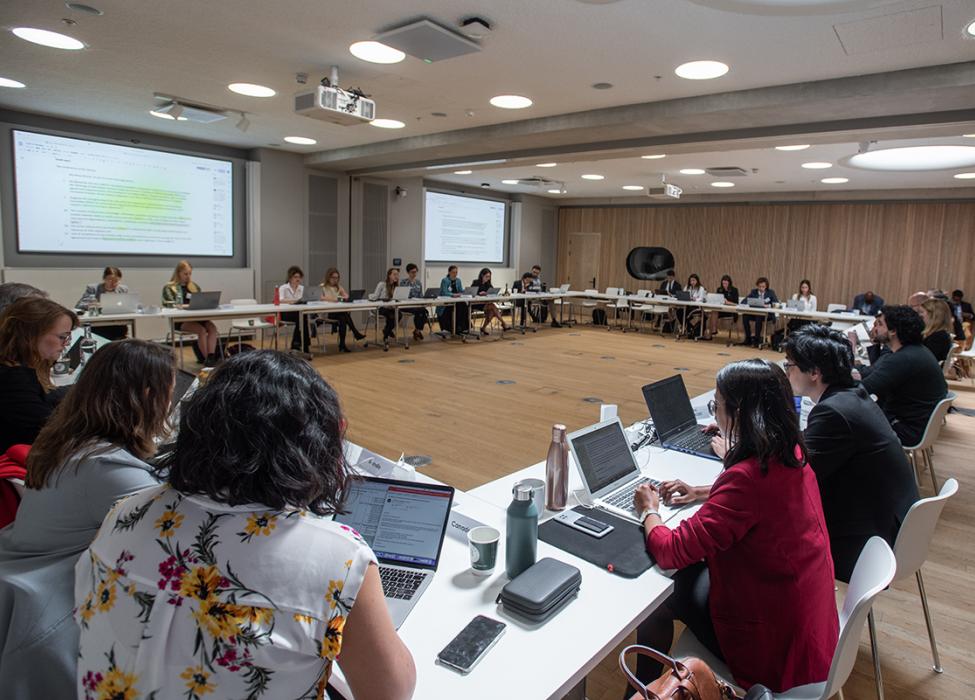Oxford students run a successful simulation ahead of COP27
MPP students report on their Policy Challenge experience of running a successful simulation of the UN Climate Change Conference due to take place next November in Sharm el-Sheikh.

Every year since 1995 countries have met at the world’s biggest climate conference - the 'Conference of the Parties' (COP). Every year impassioned speeches are made, and complicated international agreements are reached. Yet, every year the international climate conference faces criticism against its "blah blah blah".
Recently we, as part of a group of 31 Master of Public Policy (MPP) students, took international policymaking into our own hands and ran COP27 five months in advance. We did so as part of the MPP’s final class assessment, Policy Challenge II. Students were given a policy scenario (in our case, the climate crisis) and asked to run a two-day simulation (we ran the COP27 negotiations). This is the sixth time the Blavatnik School has simulated a COP.
Rather than being thrown onto a sinking iceberg, we were first given time to come to grips with climate policy. Lectures on 'hot' climate topics were delivered by a world-class teaching team: Tom Hale, Chuks Okereke and Kennedy Mbeva. We were given the opportunity to be briefed by climate experts on topics like loss and damage, mitigation, adaptation, finance, technology solutions and equity. These briefings grounded us in fertile soil for the successful conclusion of the simulation.
In the lead-up to COP27, we were allocated a country (for example Egypt or Australia) or a non-state actor (such as Exonn Mobil or C40). We prepared briefing papers and began to flesh out our interests, red lines, priorities and goals. The Oxford UNFCCC Secretary and the COP27 Presidency crafted a thoughtful agenda and assigned actors to lead either 'side events' (Just Transitions, Extreme Weather Events, Africa Agricultural Adaptation or New Technologies) or 'agenda items' (Mitigation, Adaptation, Finance or Loss and Damage).
During 'negotiation week', our diaries piled up with more meetings than Greta Thunberg’s missed school days, to set the stage for future collaborations. Tensions between climate policy (science and evidence) with the demands of politics (popularity and responsibility) quickly came to light. The pressing needs of developing countries, who had contributed least to cumulative GHG emissions but faced the largest consequences and have the least capacities to respond, also surfaced.
On the 'negotiation days', opening statements struck emotive and action-oriented chords. Despite (and in some cases, thanks to) the occasional turbulent 'breaking news item' announced by the teaching team, agreement was reached:
- On mitigation, parties updated their NDCs with an early announcement from Egypt to commit to net zero by 2050. A 'progress mechanism' to consolidate existing tools, like the Global Stocktake, was also agreed on – alongside Article 6 developments.
- On finance, the $100B commitment per year was centre-stage. The power-play of China and the US was again used to deliver a deal – $125B in total, with contributions from the US, China, United Kingdom, Japan, EU, Australia and even a last-minute 0.8B from UAE.
- On adaptation, the students agreed to reporting against a new Global Goal on Adaptation and adopting a stronger framework for National Adaptation Plans.
- On loss and damage, a facility and funding for addressing loss and damage under the Santiago Network were agreed. With technical and political leadership, Alliance of Small Island States (AOSIS) carefully crafted landing zones that saw the light thanks to coalitions established with some developed country champions (i.e. Australia and Denmark).

Photo by John Cairns
The full agreement and executive summary can be read here.
Our agreement was more ambitious than most climate agreements. Six lessons can be drawn from this unique classroom experience – and perhaps taken into the real world:
- Build unlikely coalitions. On our first day at Blavatnik School of Government, 141 students from 50+ countries were asked by Dean Ngaire Woods to ‘build unlikely coalitions’ throughout the year. Alliances were formed on negotiation topics with ease. For example, Pakistan could partner with the United Kingdom, Exonn, Egypt and the UAE in developing hydrogen infrastructure. C40 and Unilever established a fundraising initiative to reduce local climate hazards to safe levels in urban areas and small island developing states (SIDs). Forums for building unlikely coalitions need to be encouraged in Sharm-el-Sheikh in November 2022.
- Be innovative. "While students accurately represent the interests and positions of countries in the real world, they also have less 'cognitive inertia' than many actual negotiators. Fresh eyes allowed them to get to creative but still realistic ideas", says Professor Tom Hale. For example, finance negotiations were linked to ‘fair share’ contributions based on cumulative emissions. Projects for developing countries in agricultural adaptation were announced in a sort-of 'financial match-making' exercise, with more effective matches than tinder in food security and regenerative agriculture. Innovation and new techniques need to be encouraged as much as possible for future COPs.
- See the bigger picture. Mindful of the UNFCCC’s limitations but also aware of its potential, co-chairs were encouraged to step out of their narrow country perspective and see the bigger picture. The importance of neutral arbiters (such as the UNFCCC Secretary and at times, Presidency) was highlighted. In the real world, institutional settings could better support mediator roles, bearing in mind the integrity of the Agreement and processes.
- Be solution-focused. The COP President opened the conference with a challenge to see climate change as a puzzle: something to be solved. The loss and damage facility was agreed by thinking outside the box and mobilising state and non-state actors including private sector, philanthropies and local governments to contribute. Actors established, on the margins of COP, innovative and action-oriented partnerships to substantially increase climate mitigation and adaptation on the ground. It is promising to see that COP27 is already shaping up to be an 'implementation' COP.
- Use a broader toolset. Despite the overwhelming IPCC evidence, actors seemed to divert from the IPCC findings very early in the negotiations. Compromises were grounded in political and 'peer pressure' rather than in scientific evidence. The simulations, very much like the real world, could not anchor the transformations that the IPCC clearly indicates. Science is however a critical tool within a broader toolbox, in which trust and political will also play a major role.
- Hear from the newcomers. Some of the best critiques, ideas, and comments came from those that were not familiar with the COP process. They provided invaluable food for thought. Their ideas, together with the guidance of the thematic experts, and those acquainted with the UNFCCC, helped to craft the best proposals. For example, the new active role of China in the finance negotiations led to a reconfiguration and reinvigoration of the $100B goal. Newcomer contributions are needed at the upcoming COP27.
Overall, while the simulation was fake, it felt real to us. We truly hope that some of the creativity and care we put in this simulation can be embodied by our world leaders in five months’ time. It is hoped that this year, COP27 will dare to be different.


